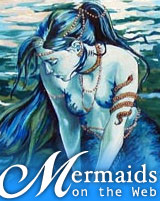
About Mermaids
Surveys | Mermaid art introductions | Academic | Reference | The Irish Merrow
Surveys
The Enchanted Waters. Heather Changeri's detailed and appealing omnigatherum of mermaid lore and art. Highlights include Scarlett deMason's article "Shadows of the Goddess—The Mermaid" , an unusually full page on the Wendish Nix, and three galleries (1, 2, 3) of mermaid art.
"Mermaid Stories" from the New York monthly Appletons' journal (May 31, 1873), a nice review of mermaid sightings and literary allusions.
"Women of the Deep: A Light History of the Mermaid" by Anthony Piccolo, from Sea History (Winter, 1993–1994). Well-written but sparsely illustrated review of mermaid lore and sightings. Answers the burning question: What do mermaids taste like? Apparently, it isn't fish or—your second guess—chicken. Piccolo writes:
"In 1739… The Scots Magazine carried a report that the crew of the ship Halifax, short on rations in the East Indies, had caught and eaten several mermaids. Upon arriving in London, the sailors described how, when taken, the creatures moaned 'with great sensibility.' The flesh, the men said, tasted like veal."
Sea Tails Online. Kurt Cagle's large and attractive mermaid universe. Many of the subpages have been distributed throughout this Mermaids on the Web. Highlights include the essay "Mermaids and the Fin de Siecle" and photoshopped photos. There are a lot of broken links in the news and links sections.
The History of Mermaids by Karen Jacubec, student project from the Australian National University. "History" here has the older meaning of "Inquiry into," and includes lots of different resources. Her historical review divides the development into three stages, "Merfolk as Gods," "Merfolk and Christianity," "Merfolk and the Rise of Science."
Shadows of the Goddess—The Mermaid by Scarlett deMason. A good summary of mermaid legends through history, from Heather Changeri's detailed The Enchanted Waters.
Mermaid.net offers booklists and a large art gallery, together with an impressive collection of commercial products, eg., clothes, sculpture, jewelry and so forth.
"Can You Hear The Mermaids Singing?" by Chandra Beal, a brief review of mermaids through history, apparently from Llewellyn's 1998 Magical Almanac.
Italian Siren/Mermaid overview.
![]()
Mermaid art introductions
For more, see Art Discussion and Galleries.
"Mermaids and the Fin de Siecle" . Resizable images, with perceptive analysis of the gender constructions behind Fin de Siecle (and much of Western) mermaids.
"Sirens especially were viewed as symbols of lesbianism, their sexuality both alluring and threatening, and like lesbian relationships (at least as the conventional wisdom of the time went), sirens viewed men as either prey to be consumed or inconsequential playthings to be destroyed. That, and their apparent inability to consumate sexual relations with a man made mermaids dangerously perverse in the Victorian mindset."
The Mermaid by Heinz Insu Fenkl, originally from Realms of Fantasy magazine (October 2003). This is a well-written jaunt through mermaids in legend and pop-culture, touching the Starbucks logo, Splash, Disney's Little Mermaid, She Creature, and Dagon. The author has gender and religious axes to grind, and there are a few errors of wishful-thinking[1]. Fenkl's attack on Disney's Little Mermaid is great. In his words, Arial is
"…an inversion of the mythic mermaid. She sacrifices her beautiful voice to gain the temporary legs that will allow her to woo her terrestrial love, Eric. While the traditional mermaids are said to seduce sailors with the sound of their beautiful singing, luring them into shipwreck and death in order to consume their souls (because they, themselves lack a soul), Ariel does exactly the reverse."
Academic
Narrative Identity: The Mermaid Myth. Psychology course taught by Wellesley prof. Jonathan Cheek. Includes an annotated bibliography , artwork and folktale resources.
Course: "Biological Mythology: A Cultural History of Animals, Anatomy, and Physiology", taught by Neil Greenberg, University of Tennessee.
Reference
Editor's comment: If you don't know, Wikipedia is a sort of "open source" encyclopedia. Anyone can edit it, anytime. Surprisingly, it usually works. Here, however, it doesn't work. Rather, mermaids is exactly the sort of topic a committee of occasional enthusiasts can't get right. There's no sense of what questions an encyclopedia article about mermaids should answer, so it hits topics randomly and incompletely. To its credit, however, it serves as a useful guide to other, more focused pages on subtopics and related topics, eg., "The Little Mermaid", The Feejee Mermaid, Nix.
Occultopedia: Mermaid . See also Siren. The Mermaid article is particularly good.
Encyclopedia Mythica: Mermaid. Article by Micha F. Lindemans. Poor. Other short articles at Selkies, Sirens, Tangaroa, etc.
The Irish Merrow
The Merrow-Folk , a fine introduction to Irish mermaids, with fairylore section of shee-eire.com, "an online guide to Ancient Ireland." See also the page on Sidhe, lake dwellers.
Wikipedia: Merrow.Meaty.
Notes:
- On one point, Fenkl cites The Woman's Dictionary of Symbols and Sacred Objects for the notion that the double-tailed mermaids on the original starbucks logo and countless churches are, in fact, "a cross between a mermaid and a sheila-na-gig," Irish spirits who flaunt their genitalia. In fact, the iconography of the double-tailed mermaid is of great antiquity (see the Ancient-18th Century Galley) and Mediterranean origin, Irish sheila-na-gigs notwithstanding. (back)

"Blue Mermaid" above courtesy Tania Henderson, www.henderart.com.
All material © 2000–2004 Tim Spalding. Books presented in association with Amazon.com.
If you enjoy this site you may like this other site by me:
Seahorse and Sea Dragon Central. Comprehensive guide to seahorse and sea dragons.
Angels on the Web. Images and other web resources on angels in Western culture, religion and art.
Hammerhead Shark! Hammerheads in all their glory, with a picture galery.